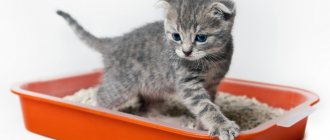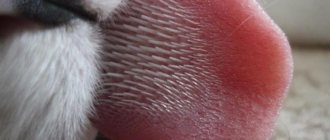16788Administration
Often, discharge from a cat on the outer labia is not considered normal and signals a problem with the animal’s health. Of course, you shouldn’t immediately panic and imagine a serious illness, because in some cases, discharge from the loop does not pose any danger.
But it won’t hurt to show your pet to a good veterinarian, since self-diagnosis is ineffective and is fraught with complications and consequences. Discharges can be very diverse :
- purulent;
- blood;
- watery;
- transparent;
- cloudy;
- white;
- gray;
- brown.
Clinical picture
Typically, owners mistake alopecia areata, or localized hair loss with the appearance of bald spots, for ringworm. This disease often accompanies four-legged pets and in modern practice is easily treatable. However, exposed areas of the body may also indicate the presence of a more serious disease in the cat’s body.
In order to recognize “dangerous” bald spots, the pet owner should pay attention to the manifestation of secondary negative signs. These include:
- Itching;
- Deterioration in wool quality;
- Peeling on the skin;
- Rash on the abdomen with redness, purulent blisters, crusts, ulcers and blisters;
- Changes in behavior, in particular, apathy, irritability and prolonged grooming, that is, the active process of cleaning the body surface;
- Changes in stool consistency, vomiting, digestive problems;
- Conjunctivitis, rhinitis, increased general body temperature;
Note! If minor bald patches appear on your pet's coat, first observe where they are located. Try changing your client's diet. The fact is that a common cause of bald patches on the coat is ordinary vitamin deficiency (especially a lack of vitamins A).
Standard options
Sometimes a cat actually actively produces saliva even when the animal is feeling normal. The causes of this condition are considered:
- reaction to tasty food;
- approaching feeding of the pet;
- motion sickness, which usually occurs when traveling in a car or other transport;
- fear, stress or anxiety of the cat.
Attention! Sometimes excessive salivation occurs if a child actively plays with the cat. This becomes a serious stress for the pet, so it tries with all its might to protect itself from such games.
It is important to note that poor pet hygiene is rarely the reason why a cat has a constantly wet chin . Since these animals are quite clean, they can wash themselves, even if the owner systematically cares for their fur.
Why do wet bald spots appear?
One of the common reasons for the appearance of one or more bald spots in a cat is injury. Representatives of the species are known for restlessness and activity, especially during the mating period, when each individual defends its own territory. If the pet simply ran into a stronger opponent and lost a tuft of hair, the spot will not itch and will quickly heal.
You might be interested in: What causes bumps on the neck of cats?
However, another development of events is also possible. You may notice a wet, bald spot on your cat, which would be classified as a bite wound. Such a bald spot does not heal for a long time, and the ichor and necrotic exudate oozing from it resemble rotting meat in smell and color. There may be several reasons for the appearance of a wet spot:
- Burns caused by prolonged exposure of the fur to sunlight;
- Thermal burns due to open flame, steam or electric current;
- Chemical burns;
- Problems with local blood circulation associated with diseases of the cardiovascular system, thrombosis, the presence of parasites in the body, etc.;
- Eczema, dermatitis (atopic or allergic) and other skin ailments, including fungal ones;
- Prolonged mechanical irritation. For example, a wet bald spot on a cat’s neck may appear due to an incorrectly selected flea collar;
- Transformation of an ordinary abrasion into a weeping wound, which turned out to be infected with pathogenic microflora;
Important! In order to determine whether the healing process of a bare spot is natural or proceeds with complications, resort to the help of your main “allies” - smell and visual inspection. If the stain shows discharge of pus and a cloudy substance, and it smells extremely unpleasant, you should consult a specialist. Owners of long-haired beauties should be on guard, because bald spots in their thick fur can be noticed too late.
Did you come home from work, sit on the sofa and notice a suspicious odor? What is that wet spot in the corner of the carpet? Who did it? Do not rush to poke the only suspect - your beloved cat - into what he did. Understand the reasons.
Cats consider the house they live in to be their territory, the boundaries of which must be marked. This is one of the reasons. Moreover, if there are other animals in the house, then the question of leadership already arises. Usually the marks are placed by the main animal - the leader. At the same time, cats let you know that the territory is occupied, and they are ready to defend it. They also report their condition – in particular, their readiness to mate. Neutered cats, by the way, can also leave a “gift”.
Stress and neurosis are another reason why marks begin to appear. When a cat lives in a family for some time, it gets used to people and considers them its own. Therefore, the absence of a family member (and a four-legged one too) or the appearance of a newcomer in the house becomes stressful.
The fuss and noise associated with renovations, moving to a new place of residence, and even the usual rearrangement of furniture unsettles them. In this case, try to capture the smell of the cat on the new furniture or on the rearranged one - wipe the animal’s face and body with a soft cloth and rub it on the corners of the furniture at the level of the cat’s head.
Tags can become a sign of protest. For example, your cat may not like where her litter box is. Place the tray in a secluded place or buy a closed tray house.
Not caught, not a thief. This principle works if you want to punish the cat for ruining something. Punish the animal only after catching it at the scene of the “crime”. Otherwise, it will associate negativity with you and continue to protest. And there are many secluded corners in the house.
Rinse the tag thoroughly and treat it with a high-quality odor remover. It’s a good idea to clean furniture like this: wash the upholstery with carpet cleaner and sprinkle with vinegar diluted in water. Rub baking soda into the stain and let it dry. Remove with a vacuum cleaner. First, make sure that the upholstery will not react by changing color. Just don't use chlorine-containing products. You can also try replacing the marks on the floor with a bowl of food.
Sometimes cats can't "do business" in the litter box because they're in pain. Notice how things happen. If these are marks, the animal turns its back to the surface (usually vertical), raises its tail and sprays a small amount of urine with the secretion of the odorous glands. During normal urination, the animal sits down and empties the bladder completely, and the puddle turns out to be impressive.
In this case, of course, you should conduct an examination - contact a veterinary clinic to identify the cause of the disease and its treatment.
But maybe your furry just doesn’t have enough attention, and he’s trying to win it in this way.
Author of the article: Aida Insanbekovna Tataeva, doctor at the veterinary clinic “Nos po Vet.ru”
Endoparasites
If you notice your pet constantly wanting to scratch a bare area, this may indicate the presence of endoparasites. For example, scratching with teeth or claws may occur in an animal due to unpleasant flea bites. In order to relieve the animal from unpleasant sensations, special solutions, sprays and drops for the withers are used. Treatment must be carried out several times in order to remove not only adult individuals from the fur, but also newly hatched larvae.
Of all the internal organs, the intestines are the most susceptible to parasite penetration. Antihelmintic drugs are excellent for removing worms from the body. However, if the case is advanced (for example, when infected with large worms), the cat may need surgical intervention.
You might be interested in: A cat scratching its butt on the carpet: worms, inflammation or irritation?
Ear mites can be treated with drops and proper care for your pet. You will need to remove him from contact with stray animals and prohibit him from eating rodents and wild birds.
Treatment. What to do if your cat has urinary incontinence?
The choice of treatment depends on the causes of urinary incontinence. If the condition can be treated with medication, there are several options available. For example, if the pathology is caused by obesity, it will require weight optimization and a strict diet; If incontinence is due to inflammation of the urinary tract or bladder, antibiotics may be used. For severe cases, surgery may be performed to remove an obstruction in the bladder or urinary tract, or to repair the bladder or urinary tract. Most cats suffering from incontinence respond well to medication and can recover completely. Inflammation is one of the most common problems associated with this disease. It is important to remember that cystitis or urolithiasis can recur, and for animals that have already been sick, it is advisable to conduct a control ultrasound of the bladder every six months and donate urine for analysis. The earlier the onset of the disease can be established, the easier and more successful the treatment is. In some cases, the onset of inflammation can be diagnosed even before it develops and manifests itself in the form of urinary incontinence.
In some cases, such as in spinal animals, treatment of the underlying cause of urinary incontinence is not possible, but it is always possible to improve the pet's quality of life and the owner's comfort.
Video of an x-ray of a cat with urinary incontinence due to spinal and pelvic trauma:
Bald spots in cats photo
How to prevent overheating and help your pet with heatstroke
Protecting your cat from overheating and heatstroke is not that difficult. It's much more difficult to help when she's already feeling bad. Follow these simple rules and your pet will be healthy even in extreme heat:
- provide constant access to cool drinking water, take a portable drinking bowl on the road;
- do not leave the cat in the car, but if there is no other choice, open the windows slightly so that there is an influx of fresh air;
- in hot weather, keep the bathroom door open so that the cat can stay in a cool room whenever she wants;
- carry out water procedures more often (the water should be slightly warm);
- You can cover the cat with a cloth soaked in cold water.
If prevention does not help, you notice alarming symptoms indicating heat stroke, act without delay. What to do:
- move the injured animal to a cool room, turn on the air conditioner or fan;
- Give him something to drink, if he refuses, forcefully pour in some water;
- Carefully dip the overheated cat in cool, but not icy, water or spray it;
- if the animal does not like bathing, wipe its face and paws with a damp cloth;
- wrap the entire cat in a damp towel;
- Massage her limbs to restore blood flow.
In especially severe cases, it is recommended to give the cat an enema with water at room temperature. But if you have never performed such a procedure, it is better not to experiment so as not to harm the animal.
When the condition is slightly normalized, measure the cat's body temperature rectally. If the thermometer shows 39.5 or lower, first aid has worked. Leave your pet cool and alone and monitor its condition. Monitor your pet’s health for at least 24 hours, because complications may not appear immediately. If you notice alarming symptoms again, take steps to cool down. If the temperature does not drop, and new reasons for concern appear, you will need the help of a veterinarian.
If your cat's condition does not improve after heatstroke, contact your veterinarian
Signs that indicate your cat will need medical attention:
- mucous membranes turn blue, breathing is intermittent, mouth is open;
- unfocused gaze, poor orientation in space;
- weak pulse, slow breathing;
- vomiting, drooling, nasal discharge;
- an unpleasant odor that was not there before;
- lack of reaction to stimuli: when a palm suddenly approaches the eyes, the cat should reflexively blink.
Heatstroke can cause serious illness
Heatstroke can lead to severe health problems for a cat. Only a veterinarian should conduct an examination, understand and prescribe treatment. Self-treatment in this case is unacceptable.
Diseases of internal organs and care errors
Problems in the functioning of the endocrine glands, pancreas, liver and stomach can provoke the formation of bald spots in different parts of the animal’s body. The existence of the disease will be confirmed by symptoms such as scabies, rash, dyspepsia, vomiting, nausea and fever.
Excessively frequent brushing or bathing with shampoo also negatively affects the quality of cat hair. A bald spot on a cat’s back can also appear due to a sudden change in hygiene product.
How does the disease manifest itself?
Because of the fur of cats, the owner cannot always detect the symptoms of eczematous pathology in his pet. However, the unbearable itching of the animal can alert him.
When examining the animal, you can notice inflamed, reddened skin at the site of scratching. Here she is tight and hot.
The situation is aggravated by the constant trauma of the claws to the inflamed area, the penetration of pathogenic bacteria into the scratches, the formation of small nodules and watery blistering rashes there.
Next, these bubbles open, pyogenic contents infected with bacteria are released from them, which gives rise to weeping areas, erosion, ulcers, and rotting of the epidermis.
The main location of this disease in cats is observed in the area:
- Back to end of tail;
- Ear areas.
Other reasons
Less common, but still significant reasons for the appearance of bald spots include:
- Sterilization. The operation provokes a change in hormonal levels, resulting in the appearance of bald spots.
- Experienced stress. In this case, bald spots are a psychogenic reaction that can be caused even by short-term experiences, for example, a change of housing or food, the appearance of another animal in the house, or the birth of a child.
- Hypercorticism. It is the synthesis of corticosteroids in the animal's body in large quantities.
- Pyoderma is a purulent skin lesion provoked by pyogenic cocci.
- Pemphigus (pemphigus).
This is interesting! If you find a bald spot on your cat's stomach, do not rush to panic. Many owners mistake an ordinary symptom for alarm... The navel! In cats, it is always located on a hairless area of the body.
In what cases is it necessary to go to the veterinarian?
The active secretion of saliva in cats performs several functions in the body. Salivation is a physiological process on which the functioning of the digestive organs depends. Saliva can also soften food and make it more pliable, which helps prevent damage to the lining of the mouth, teeth and gums. In addition, saliva has a positive effect on the receptors of the tongue.
Now it becomes clear why cats need saliva. However, its excess amount does not always indicate normal and healthy functioning of the body - it often means that the animal is sick. You need to start sounding the alarm for your pet in the following cases:
- The cat began to rub its face against the furniture or door frame.
- The pet has a wet chin, as well as a wet neck and chest.
- The animal feels unwell, which manifests itself in lethargy and weakness.
You might be interested in: What to do if your cat scratches its ears and shakes its head
In this case, you need to visit a veterinarian soon, who will examine the cat and identify the cause of excessive salivation.
Symptoms and treatment of feline eczema
Regardless of the reasons for the appearance of inflammation in the upper layer of the epidermis, the signs of the disease are the same.
- The very first symptom is redness. This occurs as a result of the fact that it is in this area of the dermis that there is lymph and blood circulation.
- Itching. The place where the inflammation began is itchy, and the cat persistently tries to scratch it. Toxins accumulate in tissues, nerve endings are irritated - this is why itching occurs.
- If you touch a red area of skin, you can record an increased temperature in this spot. Sensitivity also increases.
- As a result of intoxication, bubbles appear. In the dry form, the blisters burst and the skin peels off; usually this form is characteristic of a chronic course. In the wet form, liquid leaks from the ruptured blisters, and the wound is constantly wet. This occurs due to infection of the inflamed area. Scratched wounds receive pyogenic microflora, which provokes wet, festering wounds.
Treatment
The diagnosis must be made by a specialist and treatment prescribed.
Primary measures:
- Isolate the cat from drafts and cold places.
- Treat against fleas, worms and free her from the collar (if she is wearing) during treatment.
- If eczema is a secondary disease against the background of inflammation of internal organs (this is also determined by a veterinarian), the underlying disease must be treated.
- Analyze your pet’s diet, eliminate potential allergens, and introduce vitamins.
- It is better to shave the affected area, this will avoid infection, and also treat it with alcohol or Chlorhexidine.
Treatment with drugs:
- To reduce a cat's irritability, bromine is recommended.
- To normalize skin sensitivity, sodium thiosulfate is needed.
- Antihistamines: Suprastin, Diphenhydramine.
- Methylprednisolone, Prednisolone and Dexamethasone are effective in treating eczema.
- Furosemide is needed as a diuretic to rid the body of toxins.
- Weeping eczema in cats requires treatment with Chlorhexidine, peroxide or Miramistin.
- To provide an astringent effect, a solution of tannin or silver nitrate is required.
- Zinc ointment is suitable for drying pappules.
- If a cat has dry eczema, Vishnevsky ointment helps.
Folk remedies are also appropriate in the treatment of eczema.
- Treatment of the affected area with chamomile decoction, calendula solution, oak decoction (has an astringent effect) is effective.
- St. John's wort oil removes dry eczema and accelerates cell regeneration.
- Aloe juice has a wound healing effect.
Disease prognosis
Eczema can occur in acute and chronic forms. Acute is typical for young cats, chronic - for cats over 6 years old, as well as for weakened pets.
The acute form can last about a month, and intensive treatment is effective in combating it.
Additional symptoms
For different diseases, the following are possible:
- increased and/or difficulty urinating, which is painful and can therefore cause anxiety and even aggression;
- it’s hard for the poor thing to go “big”;
- for a long time the cat rubs its butt on the floor (or rolls on the floor);
- licks himself from behind too often, because the discharge irritates the skin;
- complete apathy; drowsiness; vomit; fever; increased thirst; poor appetite; abdominal enlargement.











